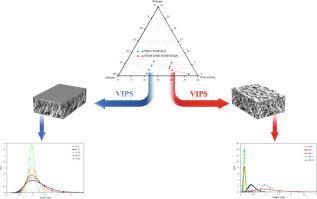Journal of Industrial and Engineering Chemistry ( IF 6.1 ) Pub Date : 2021-12-27 , DOI: 10.1016/j.jiec.2021.12.023 Amin Dehban 1 , Fatemeh Hosseini Saeedavi 2 , Ali Kargari 1

|
In this research, the pore formation mechanism of the membranes through the vapor-induced phase separation (VIPS) technique is studied. Polyvinylidene Fluoride (PVDF) microfiltration membranes are successfully fabricated by a combination of the vapor-induce phase separation (VIPS) and non-solvent-induced phase separation (NIPS), known as VIPS-NIPS method, and the influence of exposure time is investigated on the characteristics of the fabricated membranes. The membranes are characterized by scanning electron microscope (SEM) images, porosity, maximum pore radius, pore size distribution (PSD), liquid entry pressure of water (LEPw), mechanical strength, and flux of ethanol through the membrane. The results demonstrated the pore radius of the membranes increased, then decreased, and then increased again by increasing the exposure time. The narrowest pore size distribution was obtained for the membranes when the polymeric film was exposed to the humid environment for five minutes. The pore size distribution results confirmed the four-step mechanism for pore formation in the VIPS process. The nucleation points are formed on the membrane surface in the VIPS step. At low exposure times, the number of nuclei is low and they grow in the coagulation bath and form large pores. By increasing the exposure time, the number of nuclei is increased and reaches a maximum value. At this point, the growth of nuclei in the coagulation bath is minimum and results in a membrane with a smaller pore radius. Afterward, by increasing the VIPS time, the nuclei become larger and join each other to make larger pores, therefore, a wider pore size distribution with a larger average pore radius of the membrane would be expected.
中文翻译:

用VIPS-NIPS技术制备膜的成孔机理研究
在这项研究中,通过气相诱导相分离(VIPS)技术研究了膜的孔形成机制。采用气相诱导相分离 (VIPS) 和非溶剂诱导相分离 (NIPS) 方法成功制备聚偏二氟乙烯 (PVDF) 微滤膜,并研究了暴露时间的影响。关于制造的膜的特性。膜通过扫描电子显微镜 (SEM) 图像、孔隙率、最大孔半径、孔径分布 (PSD)、水的液体进入压力 (LEPw)、机械强度和乙醇通过膜的通量来表征。结果表明,随着暴露时间的增加,膜的孔隙半径先增加,然后减少,然后再次增加。当聚合物膜暴露于潮湿环境五分钟时,膜的孔径分布最窄。孔径分布结果证实了 VIPS 工艺中孔形成的四步机制。在 VIPS 步骤中,成核点在膜表面上形成。在低曝光时间下,细胞核的数量很少,它们会在凝固浴中生长并形成大孔。通过增加曝光时间,核数增加并达到最大值。此时,凝固浴中的核生长最少,并导致膜具有较小的孔半径。之后,通过增加 VIPS 时间,核变大并相互连接形成更大的孔,因此,



























 京公网安备 11010802027423号
京公网安备 11010802027423号